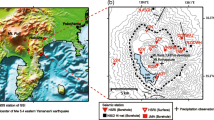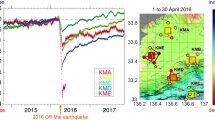Abstract
Ambient noise correlation analyses are largely used in seismology to map heterogeneities and to monitor the temporal evolution of seismic velocity changes associated mostly with stress field variations and/or fluid movements. Here we analyse a small earthquake swarm related to a main mR 3.7 intraplate earthquake in North-East of Brazil to study the corresponding post-seismic effects on the medium. So far, post-seismic effects have been observed mainly for large magnitude events. In our study, we show that we were able to detect localized structural changes even for a small earthquake swarm in an intraplate setting. Different correlation strategies are presented and their performances are also shown. We compare the classical auto-correlation with and without pre-processing, including 1-bit normalization and spectral whitening, and the phase auto-correlation. The worst results were obtained for the pre-processed data due to the loss of waveform details. The best results were achieved with the phase cross-correlation which is amplitude unbiased and sensitive to small amplitude changes as long as there exist waveform coherence superior to other unrelated signals and noise. The analysis of 6 months of data using phase auto-correlation and cross-correlation resulted in the observation of a progressive medium change after the major recorded event. The progressive medium change is likely related to the swarm activity through opening new path ways for pore fluid diffusion. We further observed for the auto-correlations a lag time frequency-dependent change which likely indicates that the medium change is localized in depth. As expected, the main change is observed along the fault.










Similar content being viewed by others
References
Assumpção, M. (1983), A regional magnitude scale for Brazil, Bull. Seism. Soc. Am., v. 73, n. 1, p. 237–246.
Baisch, S., and Bokelmann, G.H.R. (2001), Seismic waveform attributes before and after the Loma Prieta earthquake: Scattering change near the earthquake and temporal recovery, J. Geophys. Res. 106, 16323– 16337.
Bensen, G.D., Ritzwoller, M.H., Barmin, M.P., Levshin, A.L., Lin, F., Moschetti, M.P., Shapiro, N.M., and Yang, Y. (2007), Processing seismic ambient noise data to obtain reliable broad-band surface wave dispersion measurements, Geophys. J. Int. 169, 1239–1260.
Bezerra, F.H.R., do Nascimento, A.F., Ferreira, J.M., Nogueira, F.C., Fuck, R.A., Brito Neves, B.B., and Sousa, M.O.L (2011), Review of active faults in the Borborema Province, Intraplate South America—Integration of seismological and paleoseismological data, Tectonophysics 510, 269–290.
Bosl, W.J., and Nur, A. (2002), Aftershocks and pore fluid diffusion following the 1992 Landers earthquake, J. Geophys. Res. 107, 2366–2368.
Brenguier, F., Shapiro, N.M., Campillo, M., Ferrazzini, V., Duputel, Z., Coutant, O., and Nercessian A. (2008a), Towards forecasting volcanic eruptions using seismic noise, Nat. Geosci. 1, 126–130.
Brenguier, F., Campillo, M., Hadziioannou, C., Shapiro, N.M., Nadeau, R., and E. Larose (2008b), Postseismic relaxation along the San Andreas fault at Parkfield from continuous seismological observations, Science 321, 1478–1481.
Campillo, M., and Paul, A. (2003), Long-range correlations in the diffuse seismic coda, Science 299, 547–549.
Derode, A., Larose, E., Tanter, M., de Rosny, J., Tourin, A., Campillo, M., and Fink, M. (2003), Recovering the Green’s function from field-field correlations in an open scattering medium, J. Acoust. Soc. Am., 113, 2973–2976.
Do Nascimento, A.F., Cowie, P.A., Lunn, R.J., Pearce, R.G. (2004) Spatio-temporal evolution of induced seismicity at Acu reservoir, NE Brazil, Geophys. J. Int. 158, 1041–1052.
Do Nascimento, A.F., Lunn, R.J., Cowie, P.A. (2005), Modeling the heterogeneous hydraulic properties of faults using constraints from reservoir-induced seismicity. J. Geophys. Res. 110, B09201.
Do Nascimento, A.F., Lunn, R.J., Cowie, P.A. (2005), Numerical modelling of pore-pressure diffusion in a reservoir-induced seismicity site in northeast Brazil. Geophys. J. Int. 160, 249–262.
Ferreira, J.M., Bezerra, F.H.R., Sousa, M.O.L., Do Nascimento, A.F., Sá, J.M., and França, G.S. (2008), The role of Precambrian mylonitic belts and present-day stress field in the coseismic reactivation of the Pernambuco lineament, Brazil. Tectonophysics 456, 111–126.
Gavrilenko, P. (2005), Hydromechanical coupling in response to earthquakes: on the possible consequences for aftershocks. Geophys. J. Int. 161, 113–129.
Gavrilenko, P., Singh, C., and Chadha, R.K. (2010), Modelling the hydromechanical response in the vicinity of the Koyna reservoir (India): Results for the initial filling period. Geophys. J. Int. 183, 461–477.
Grêt, A., R. Snieder, R.C. Aster, and P.R. Kyle, Monitoring rapid temporal changes in a volcano with coda wave interferometry. Geophys. Res. Lett. 32, L06304, doi:10.1029/2004GL021143, 2005.
Groenenboom, J., and Snieder, R. (1995), Attenuation, Dispersion and Anisotropy by Multiple Scattering of Transmitted Waves Through Distributions of Scatterers. J. Acoust. Soc. Am. 98, 3482–3492.
Hadziioannou, C., Larose, E., Baig, A., Roux, P., and Campillo, M. (2011), Improving temporal resolution in ambient noise monitoring of seismic speed, J. geophys. Res. 116, B07304.
Hobiger, M., Wegler, U., Shiomi, K., and Nakahara, H. (2014), Single-station cross-correlation analysis of ambient seismic noise: application to stations in the surroundings of the 2008 Iwate-Miyagi Nairiku earthquake, Geophys. J. Int. 198.
Larose, E., Planès, T., Rossetto, V., and Margerin, L. (2010), Locating a small change in a multiple scattering environment, Appl. Phys. Lett. 96, 1–3.
Lima Neto, H.C., Ferreira, J.M., Bezerra, F.H., Assumpção, M., Do Nascimento, A.F., Sousa, M., and Menezes, E. (2013), Upper crustal earthquake swarms in São Caetano: Reactivation of the Pernambuco shear zone and trending branches in intraplate Brazil, Tectonophysics 608, 804–811.
Lobkis, O.I., and Weaver, R.L. (2001), On the emergence of the Green’s function in the correlations of a diffuse field, J. acoust. Soc. Am. 110, 3011–3017.
Lopes, A. E. V., Assumpção, M., Do Nascimento, A. F., Ferreira, J. M., Menezes, E. a. S., and Barbosa, J. R. (2010), Intraplate earthquake swarm in Belo Jardim, NE Brazil: reactivation of a major Neoproterozoic shear zone (Pernambuco Lineament). Geophys. J. Int. 180, 1303–1312.
Maeda, T., Obara, K., and Yukutake, Y. (2010), Seismic velocity decrease and recovery related to earthquake swarms in a geothermal area, Earth, Planets and Space 62, 685–691.
Meier, U., Shapiro, N., and Brenguier, F. (2010), Detecting seasonal variations in seismic velocities within Los Angeles Basin from correlations of ambient seismic noise, Geophys. J. Int. 181, 985–996.
Miller, S.A., Collettini, C., Chiaraluce, L., Cocco, M., Barchi, M., and Kaus, B.J.P. (2004), Aftershocks driven by a high-pressure CO 2 source at depth, Nature 427, 724–27.
Minato, S., Tsuji, T., Ohmi, S., and Matsuoka, T. (2012), Monitoring seismic velocity change caused by the 2011 Tohoku-oki earth- quake using ambient noise records, Geophys. Res. Lett. 39, L09309.
Mordret, A., A. Jolly, Z. Duputel, and N. Fournier (2010), Monitoring of phreatic erup- tions using Interferometry on Retrieved Cross-Correlation Function from Ambient Seismic Noise: Results from Mt. Ruapehu, New Zealand, J. Vol. Geotherm. Res. 191, 46–59.
Nakahara, H. (2015), Auto Correlation Analysis of Coda Waves from Local Earthquakes for Detecting Temporal Changes in Shallow Subsurface Structures: the 2011 Tohoku-Oki, Japan Earthquake, Pure Appl. Geophys. 172, 213–224.
Nur, A., and Booker, J.R. (1972), Aftershocks caused by pore fluid flow? Science 175, 885–887.
Ohmi, S., Hirahara, K., Wada, H., and Ito, K. (2008), Temporal variations of crustal structure in the source region of the 2007 Noto Hanto earthquake, central Japan, with Passive Image Interferometry, Earth Planets Space 60, 1069–1074.
Poupinet, G., Ellsworth, W.L., and Frechet, J. (1984), Monitoring velocity variations in the crust using earthquake doublets: an application to the Calaveras fault, California, J. Geophys. Res. 89, 5719–5731.
Pytharouli, S.I., Lunn, R.J., Shipton, Z.K., Kirkpatrick, J.D., Do Nascimento, A.F. (2011), Microseismicity illuminates open fractures in the shallow crust, Geophys. Res. Lett. 38, L02402.
Roux, P., Sabra, K.G., Gerstoft, P., Kuperman, W.A., and Fehler M.C. (2005), P-waves from cross-correlation of seismic noise, Geophys. Res. Lett. 32, L19303.
Roux, P., and Ben-Zion, Y. (2013), Monitoring fault zone environments with correlations of earthquake waveforms, Geophys. J. Int. 196, 1073–1081.
Schimmel, M., and Paulssen, H. (1997), Noise reduction and detection of weak, coherent signals through, Geophys. J. Int. 130, 497–505.
Schimmel, M. (1999), Phase Cross-Correlations: Design, Comparisons, and Applications, Bull. Seismol. Soc. Am. 89, 5, 1366–1378.
Schimmel, M., Stutzmann, E., and Gallart, J. (2011), Using instantaneous phase coherence for signal extraction from ambient noise data at a local to a global scale, Geophys. J. Int. 184, 494–506.
Sens-Schönfelder, C., and Wegler, U. (2006), Passive image interferometry and seasonal variations of seismic velocities at Merapi Volcano, Indonesia, Geophys. Res. Lett. 33, L21302.
Shapiro, N.M., Campillo, M., Stehly, L., and Ritzwoller, M.H. (2005), High resolution surface wave tomography from ambient seismic noise, Science 307, 1615–1618.
Sibson, R. (1996) Structural permeability of fluid-driven fault-fracture meshes, J. Struct. Geol. 18, 1031–1042.
Snieder, R., Grêt, A., Douma, H., and Scales, J. (2002), Coda wave interferometry for estimating nonlinear behaviour in seismic velocity, Science 295, 2253–2255.
Snieder, R. (2004a), Coda wave interferometry, in “2004 McGraw-Hill Yearbook of Science & Technology”, 54-56, McGraw-Hill, New York.
Snieder R. (2004b), Extracting the Green’s function from the correlation of coda waves: a derivation based on stationary phase, Phys. Rev. E 69:046610.
Snieder, R., Hubbard, S., Haney, M., Bawden, G., Hatchell, P., Revil, A., and DOE Geophysical Monitoring Working Group (2007), Advanced Noninvasive Geophysical Monitoring Techniques. Annu. Rev. Earth Planet. Sci. 35, 653–83.
Soden, A.M., Shipton, Z.K., Lunn, R.J., Pytharouli, S.I., Kirkpatrick, J.D., Do Nascimento, A.F., and Bezerra, F.H.R. (2014), Brittle structures focused on subtle crustal heterogeneities: implications for flow in fractured rocks, Journal of the Geological Society 171, 509–524.
Sykes, L.R. (1978), Intraplate seismicity, reactivation of preexisting zones of weakness, alkalinemagmatism, and other tectonism postdating continental fragmentation, Rev. Geophys. Space Phys. 16, 621-688.
Terakawa, T., Zoporowski, A., Galvan, B., and Miller, S. (2010), High‐ pressure fluid at hypocentral depths in the L’Aquila region inferred from earthquake focal mechanism, Geology 38,995–998.
Wapenaar, K. (2004), Retrieving the elastodynamic Green’s function of an arbitrary inhomogeneous medium by cross correlation. Phys. Rev., Lett. 93, 254301.
Wegler, U., and Sens-Schönfelder, C. (2007), Fault zone monitoring with passive image interferometry, Geophys. J. Int. 168, 1029–1033.
Wegler, U., Nakahara, H., Sens-Schönfelder, C., Korn, M., and Shiomi, K. (2009), Sudden drop of seismic velocity after the 2004 M w 6.6 mid-Niigata earthquake, Japan, observed with Passive Image Interferometry, J. Geophys. Res. 114, B06305.
Zaccarelli, L., Shapiro, N.M., Faenza, L., Soldati, G., and Michelini, A. (2011), Variations of crustal elastic properties during the 2009 l’aquila earthquake inferred from cross- correlations of ambient seismic noise, Geophys. Res. Lett., 38.
Zhan, Z., Tsai, V.C., and Clayton, R.W. (2013), Spurious velocity changes caused by temporal variations in ambient noise frequency content. Geophys. J. Int. 194, 1574–1581.
Acknowledgments
The authors thank the Instituto Nacional de Ciência e Tecnologia—Estudos Tectônicos (INCT-ET/CNPq) and the Instituto Nacional de Ciência e Tecnologia—Geofísica do Petróleo (INCT-ET/CNPq). V. D’hour and H. Lima Neto thank CAPES for their PhD grants. A. Nascimento and J. Ferreira thank CNPq for their PQ grants. M. Schimmel thanks the Science without Borders Programme for his PVE grant and CGL2013-48601-C2-1-R. V. D’hour also thanks the Science without Borders Programme for allowing the sponsored period of 1 year in Barcelona, Spain. The authors also thank Eduardo Menezes for this valuable work in the data acquisition period, and the editor and the 2 reviewers for their careful and constructive reviews.
Author information
Authors and Affiliations
Corresponding author
Rights and permissions
About this article
Cite this article
D’Hour, V., Schimmel, M., Do Nascimento, A.F. et al. Detection of Subtle Hydromechanical Medium Changes Caused By a Small-Magnitude Earthquake Swarm in NE Brazil. Pure Appl. Geophys. 173, 1097–1113 (2016). https://doi.org/10.1007/s00024-015-1156-0
Received:
Revised:
Accepted:
Published:
Issue Date:
DOI: https://doi.org/10.1007/s00024-015-1156-0




